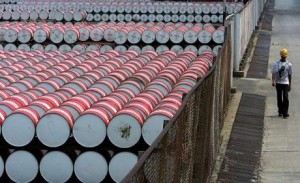 West Texas Intermediate crude edged higher on Wednesday after a government report showed supplies at Cushing, Oklahoma, fell for a fourth consecutive week in the seven days through February 21st, while nationwide crude inventories rose less than expected.
West Texas Intermediate crude edged higher on Wednesday after a government report showed supplies at Cushing, Oklahoma, fell for a fourth consecutive week in the seven days through February 21st, while nationwide crude inventories rose less than expected.
On the New York Mercantile Exchange, WTI futures for settlement in April traded at $102.80 per barrel at 15:38 GMT, up 0.95% on the day. Prices held in a daily range between $102.87 and $101.58 per barrel. The US benchmark slid by nearly 1% on Tuesday, the most in three weeks, and settled at the lowest since February 14th but managed to jump back to positive weekly territory following Wednesdays advance.
Meanwhile on the ICE, Brent futures for delivery in the same month jumped by 0.31% to $109.85 per barrel by 15:42 GMT and shifted in a daily range between $109.20 and $109.93 a barrel. The European benchmark lost 1% on Tuesday and narrowed its premium to WTI to $7.68, down from $7.82 on Monday, based on closing prices.
Oil prices recovered on Wednesday after the Energy Information Administration reported a fourth consecutive weekly drop at the biggest US storage hub. Supplies at Cushing, Oklahoma, the delivery point for NYMEX-traded contracts, fell to 34.8 million barrels in the seven days through February 21st from 35.9 million in the previous week. Stockpiles declined by 7 million barrels in the last four weeks to the lowest since mid-October as TransCanada commissioned the southern leg of its KeystoneXL pipeline, which began carrying oil from Cushing to Texas, easing a bottleneck. The line is supposed to reach its 700 000-bpd capacity throughout the year, its operator said.
The government agency also reported that the nations crude oil inventories rose by a mere 68 000 barrels last week, outperforming the median estimate of ten analysts surveyed by Bloomberg for a build of 1.275 million barrels. At 362.4 million barrels, US crude supplies are in the upper half of the average range for this time of year.
Refineries operated at 88% of their operable capacity. Motor gasoline production decreased, while distillate fuel output gained, averaging 8.7 million and 4.6 million barrels per day, respectively.
The EIA also reported that total motor gasoline inventories plunged by 2.8 million barrels last week, exceeding analysts projections for a 1-million drop, but remained in the upper half of the average range for this time of the year. Distillate fuel supplies, which include diesel and heating oil, rose for the first time in seven weeks. Distillate stocks rose by 0.3 million barrels, defying expectations for a 1.25-million drop, but remained well below the lower limit of the average range.
The oil market was pressured on Tuesday and earlier on Wednesday as weak economic data from the US fueled concerns over the US economys recovery state. US home prices rose slower in December from a year earlier, with the S&P/Case-Shiller Composite-20 Home Price Index posting at 13.4%, down the preceding month’s 13.7% reading. However, the slowdown outperformed analysts’ expectations for a drop to 13.3% and was largely attributed to the surprisingly cold winter in the US.
Meanwhile, declining consumer sentiment in the US also helped push prices lower. The Conference Board reported that its consumer confidence index slid to 78.1 in February, confounding analysts’ expectations for a jump to 80.0. Moreover, January’s reading received a downward revision to 79.4 from initially estimated at 80.7.
The oil complex however, and especially the Brent benchmark, drew additional support after another series of battles between the Libyan government and rebel autonomy groups demanding a greater share of the nation’s oil wealth. In the latest sign of the official government’s inability to regain full control of the nation’s oil production, more than 100 rockets were launched in clashes between government forces and militias, which shut a power plant in southern Libya.
The African country, holder of the continent’s biggest crude reserves, is producing an average of 231 000 barrels per day after renewed protests shut the western El Sharara oilfield on February 20th, the state-run National Oil Corporation said.





